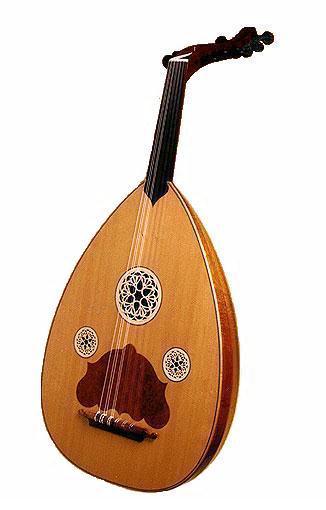
Since I was very young I've been a fan of lute music but I've only recently fallen in love with its older brother, oud music. Oud is the etymological root of lute (nice rhyme, ed.).
European lute music is very beautiful, in particular for expressing sadness and melancholy. John Dowland's Lachrimae are masterpieces of the form. I saw them as slightly repressed guitars, pale and slightly cold. And with that aura of the past. Here's an example:
Now don't get me wrong. This is European lute music at the top of its game. I've listened to this for hours on end. I'm as in love with it as anyone could be I reckon.
But all those impressions of what lutes did were burnt away by Le Trio Joubran, a trio of very much alive and kicking Palestinian men. Many bands I've been in would KILL for riffs like that. Totally fresh, on an instrument I thought was an antique, in my stunning ignorance. Here they are:
Now roughly an oud is the same object as a lute. How come you can get such different sounds from it, such different translations? (And while we're on that subject, how tragic is it that Europe went the way of equal temperament and careful, symmetrical musical structures. I mean, come on, I know which music seems to impel itself on me, without asking first, summoning all kinds of energies, some of them terrifying, some passionate, dark, magnificent. And it's not the European style.)
Three guesses: it starts with a /w/ and it ends with an /l/ and it's what objects do best...
8 comments:
You could make a similar contrast between classical trumpet and jazz trumpet, where the instruments are the same. Not only are the melodies and riffs different, but the sounds are different. Different way of assimilating the instrument to your body, perhaps.
Hamza el-Din!
the Le Trio Joubran video is great. very dark. works in a cool mode (phrygian?)/scales that metal bands like Nile borrow from.
(Withdrawal - its in the sibject labels!)
Bill that's a great observation. The timbre is different isn't it? And the rhythm for sure. It's a mistake, I think, to imagine that 4/4 is a machine and that syncopation is just kinks in that machine, when playing jazz--am I right? I shall defer to your wisdom on this.
Yes, Tim. The range of timbre in jazz trumpeters is much larger than in classical or 'legit' trumpeters. And you're right about syncopation, it's not kinks in the 4/4 machine. It's different gearing and camshafts. Here's a little group improv for you:
Peace Now!
I'm somewhere in there on trumpet. I did some of that nasty growly animal stuff. & I did the photos.
I have heard it said that the Irish knew of blue-notes long before the rise of jazz and other blues-styles, which is why much "country" music from the SE, where not an insignificant amount of Scotch-Irish settled in the 17th and 18th centuries, is twangy and reminiscent of blues-styles descending from Africa. I think bluegrass was a corollary of American jazz in this respect for producing a soulful yet energetic an technically interesting sound.
And there's this, Tim: As I understand it, part of your line on Nature-Over-There is that the Romantics did that to Us/Nature. Well, they also gave us the cult of the genius, no? And that means that we, you and me and the rest of them, are HERE, and the REAL MUSIC is OVER THERE, being played by THE GENIUS. I dare say that since then pop music has staged one protest after another against that division and bifurcation. What really kicked up the intensity of this dynamic was the invention of effective ways of mediating music, that is, separating the music from the performers. Broadcast and recording allow large numbers of people to listen to and dance to music without being in the presence of performers. So now music-making is something for kids, but adults no longer do much of it.
The question I've been asking in the most serious way is this: Are we harming our biology, our physical selves, by thus downgrading music. Does human biology work best in a world saturated with group music-making? Here's an abstract of some notes I've written up:
Music and the Prevention and Amelioration of ADHD: A Theoretical Perspective (go here to download)
Russell A. Barkley has argued that ADHD is fundamentally a disorientation in time. These notes explore the possibility that music, which requires and supports finely tuned temporal cognition, might play a role in ameliorating ADHD. The discussion ranges across cultural issues (grasshopper vs. ant, lower rate of diagnosis of ADHD among African-Americans), play, distribution of dopamine and norepinephrine in the brain, neural development, and genes in culture (studies of the distribution of alleles for dopamine receptors). Unfortunately, the literature on ADHD does not allow us to draw strong conclusions. We do not understand what causes ADHD nor do we understand how best to treat the condition. However, in view of the fact that ADHD does involve problems with temporal cognition, and that music does train one’s sense of timing, the use of music therapy as a way of ameliorating ADHD should be investigated. I also advocate conducting epidemiological studies about the relationship between dancing and music in childhood, especially in early childhood, and the incidence of ADHD.
Interesting you should bring up the blue notes, Joe. 'Cause they may have come to the Irish from the land of the oud. Middle Eastern musical features made their way to America through two routes. One route goes southwest through West Africa and thence across the Atlantic. The other route goes northwest through the British Isles and especially Ireland.
Post a Comment